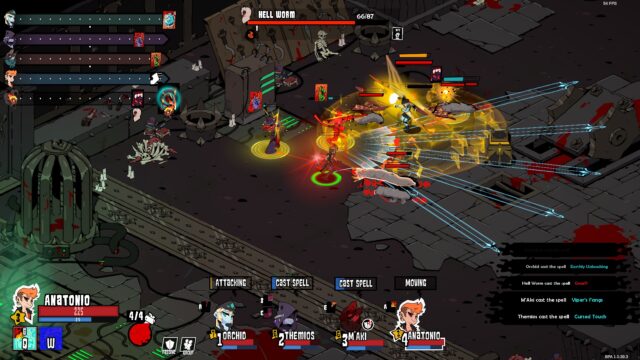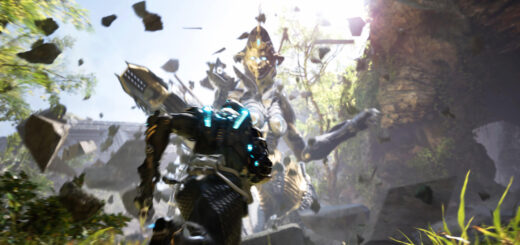Blade Prince Academy Review
School’s Out
There’s always a hope with smaller developers that any game they create can become a surprising gem. Angel Corp’s Blade Prince Academy looks to become one almost entirely through its unique gameplay. The core combat is quick, snappy, and consistently keeps players on their toes. Unfortunately, the presentation surrounding this gameplay ranges from half-baked to frustratingly passable.
In Blade Prince Academy, the player follows the exploits of the eponymous academy students after the school is attacked by a gang of thugs. Believing there to be more behind these thugs the Blade Princes venture forth to save their captured compatriots and figure out the mystery behind why the school was targeted. This leads to uncovering other enemy factions, that largely coincide with each new biome players venture into. Between enemy and player ideologies the game feels as though it’s moving in fast-forward and not enough time is spent on developing character motivations. This bleeds into the world building as exposition is dumped suddenly and conflicts are often resolved quickly after being introduced.
The academy acts as a base of operations. Players have the option to upgrade their potions and equipment, view conversations between characters, or rest party members. Many of the sudden exposition dumps come during these chats. Key aspects to the characters’ backstories are just casually tossed out as if they were talking about the weather. This doesn’t add much to the team building aspect, but does add to the fast-forward nature of the storytelling.
Resting party members doesn’t cost money, but being unable to field a team due to too many characters snoozing and therefore skipping the week does. Resting is important to replenish energy, because running out causes debilitating attribute drops. Skipping a week has the characters mention doing an inane activity that costs a random amount of currency and pushes time ahead. Time, however, is a rather fruitless concept in Blade Prince Academy as the only reason that a time limit is imposed is to keep track of parties. A party occurs every two months roughly and if a character doesn’t use energy to plan for it, a poor outing then creates a large decrease in relationship with one another. Decreases don’t affect the characters in any way, and in fact after three negative drops it only took one prepared school party to have the entire team friendly with one another.
It’s difficult to connect to the Blade Princes since every character’s story is very minor, being brought up and concluded in a short time, usually soon after recruitment. Sometimes these threads do last longer, but they often rehash aspects that are already known and leave no real staying power. Even in the longer story sections, there’s little building of the narrative, just a general feeling of the moment.
Blade Prince Academy‘s combat plays out in real-time, moving quickly to ensure that players utilize the pause function so that next moves can be planned out. Moves have to be considered carefully as there’s no backing out after it has been selected, and careless use of some abilities will lead to character deaths. Friendly fire is very much a concern; anyone blundering into the range of an effect will be hit, friend or foe. Health and mana points recover automatically on a slow timer, which can be accelerated with potions. Potions are dropped by enemies or bought from the school, but run out quickly if players aren’t careful. Medkits are always available and can be used post-battle to revive any fallen party members. Full team knockouts result in experience loss and causes time to move forward a week.
There are eleven different characters to be recruited, with up to four able to be deployed at a time. The game takes players through four biomes, each containing at least eight quests, most of which require at least one specific member to be used. Juggling every character in Blade Prince Academy is a necessity due to these restrictions. Luckily, most of the characters are unique, with only a few skills overlapping, and combine with one another in ways that make mixing and matching fun to do. Using the same teams can be useful when building relationships as the higher the bond the higher the attribute boosts when used together.

Be careful where area of effect abilities are aimed, don’t want to take out a party member by accident.
Each of the seven skills that the Blade Princes can learn has a secondary function that only unlocks when specific conditions are met. For example, when an enemy is taunted by one of the several tanks in the party then Phoebos’s Burning Chains ability also incorporates a new skill called Fire Nova for additional AoE damage. While every skill, offensive and defensive, has a combo ability, there is a limited number of combinations. Some are easier to pull off than others, and figuring out which partners work best together is always a fun balancing act. Pausing offers the important thinking time needed to set up these combos.
Combat can get frustrating as a lot of moving parts are being juggled. Enemies are relentless, and everything is fast. Allies do a basic auto-attack when within range of an enemy, but everything else relies on player input. It’s easy to lose track and end up with characters standing still after an enemy is defeated or lingering in an acid pit taking damage. Melee attackers also won’t close the distance to any ranged attackers until moved there by the player. With the urgency entirely on the player’s end it makes pausing more important to make sure that powerful attacks are avoided or characters aren’t sitting there taking unnecessary damage. The game at least auto pauses when a character reaches low life, while potions can be used in the pause screen. Playing defensively is just as important as being offensive, as proper movement when waiting for cooldowns can mean the difference between survival and losing the quest.
One way to try and power up regular attacks is through pacts, equipment found in treasure chests that can be applied to anyone for attribute boosts or passive effects such as extra projectiles or expanded areas of effect. Pacts also have their issues. Each biome has its own set pacts that can be found in treasure chests. These treasure chests provide a choice of four different pacts that can only be taken by a character with an open slot available. Removing pacts costs money back at the academy so choosing only useful pacts is important. This is frustrating when random chance makes a better pact appear and no one can equip it, in which case it is discarded for minimal funds. Pacts can be enchanted to prolong their usefulness, but this can only happen once and it costs extra money to swap out enchantment options beyond the two available. If a character has space for more pacts they can stack up, this ends with specialized party members hunting for specific gear while traversing dungeons.
Since biomes have specific pacts available some characters go a while without obtaining an upgrade. For example, the first biome is the only one with a natural armour bonus. Enchantments give a smaller attribute boost than pacts normally have, which leads to searching for duplicates to boost numbers rather than relying on what’s currently available. Since players are backtracking to do this there’s minimal experience gained, which means players have to hope for random chance to give the correct pact for the experience to be worthwhile. Luckily, re-running quests is quickly completed as they only take a few minutes.
Character portraits feature line work that makes them pop out in an eye-catching manner. In-game sprites don’t have the same attention given to them but are serviceable and visually work in tandem with their portraits. Basic enemies rarely change outside of the beginning of a new biome making them feel repetitive outside of boss encounters. Bosses stand out a bit more since they have portraits to help illuminate them. While there are different tracks for each biome, they are noticeably short, repeat after a short length of time, and truly don’t get a chance to stand out. The sound design doesn’t get in the way of the frantic combat either, but, like the soundtrack, feel pushed aside in order to focus on the gameplay.
There’s a lot of little pieces that work in Blade Prince Academy, mostly on the combat side. Characters have snappy designs, but the fast-forward plot makes their personalities feel stilted. The game is ultimately a passable, but not fully realized, experience with the novel gameplay the only element that stands out. It is likely worth a look for those with whom the style resonates, just be prepared for fast thinking or copious use of the pause button.
Disclosure: This review is based on a free copy of the game provided by the publisher.


Combat always keeps players on their toes
Every character is worthwhile to use
Character portraits are well designed
Story is presented in fast-forward
None of the other presentational aspects stand out to help elevate the gameplay








Recent Comments